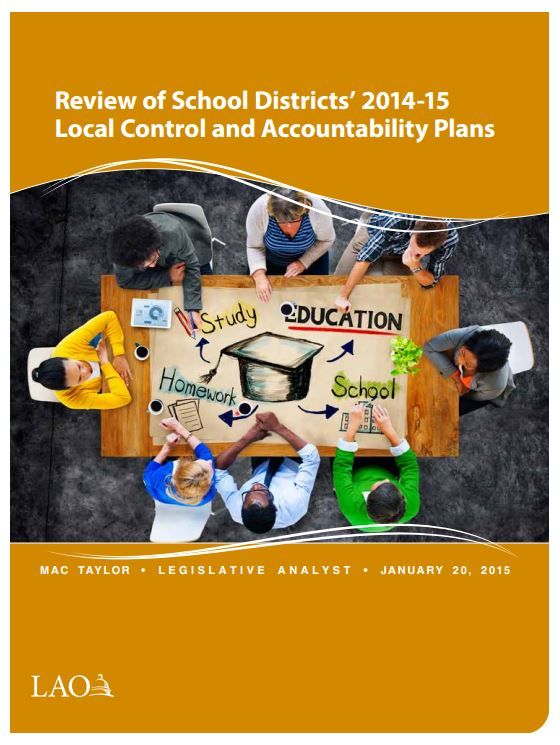LAO questions local school funding accountability
 When Gov. Jerry Brown signed legislation in July 2013 that increased funding for the state’s neediest students and restored local control over how that money is spent, he hailed it as “historic.”
When Gov. Jerry Brown signed legislation in July 2013 that increased funding for the state’s neediest students and restored local control over how that money is spent, he hailed it as “historic.”
Brown also called it “truly revolutionary. We are bringing government closer to the people, to the classroom where real decisions are made, and directing the money where the need and the challenge is greatest. This is a good day for California, it’s a good day for school kids and it’s a good day for our future.”
But nearly two years and $7 billion later (with another $4 billion in Brown’s proposed 2015-16 budget), state officials are not sure the intended targets of the Local Control Funding Formula – English learners, students in low-income families and foster-care youth – are actually benefiting.
School districts are required to file a Local Control and Accountability Plan with the state that specifies how they are using the extra LCFF funding to benefit those three categories of students. But many districts’ plans have failed to provide clarity.
That lack of clarity was confirmed in a recent study of the LCAPs from 50 school districts by the Legislative Analyst’s Office.
Carolyn Chu, a senior fiscal and policy analyst at the LAO, testified on the study before the Assembly Budget Subcommittee on Education Finance. “It was difficult to determine how districts were increasing or improving services for English learners, low-income and foster youth students in accordance with the regulations,” she said. “Districts are required to increase or improve services in proportion to the funding that they receive. And it was difficult for us to determine how districts were doing that through reading their LCAP.”
 General programs
General programs
The study itself concluded, “In most LCAPs, we found that districts are not distinguishing between actions that are a continuation of efforts from the prior year and those that are new for the upcoming school year. Without such differentiation, we could not determine whether districts were using the new funding generated under LCFF to pursue new actions to improve performance or to continue or expand prior activities.”
Instead of targeting the funds at English learners, low-income and foster-care students, many school districts are using the money for general programs with the understanding that those three subgroups are also benefiting, according to the LAO. “[F]ew districts provide clear or compelling rationales for using their … funds on a districtwide and schoolwide basis,” the study said.
Among the study’s findings, few districts provide specifics on how they are implementing the state’s Common Core and English language development standards, how they are increasing parental involvement and how they are ensuring student enrollment in all required areas of study.
No information
Some provide no information at all on supplemental services for English learner, low-income and foster care students.
“Often, districts’ justifications of districtwide and schoolwide services consist only of recapping the actions they will pursue on behalf of all students and indicating those actions also will benefit EL/LI students,” the study said.
“Though few districts provided clear or compelling rationales for using their supplemental and concentration funds on a districtwide and schoolwide basis, this lack of clarity seems most problematic for districts with relatively low proportions of EL/LI students — districts for whom targeted services generally would be more appropriate.”
Complexity
Part of the problem is the complexity of the new regulations.
“One of our most significant findings relates to the overarching design of the LCAP,” the LAO study said. “The statute governing the components of the LCAP requires districts to set goals in eight state priority areas, identify and describe actions to reach those goals, and track progress using 24 state-identified metrics (plus any local metrics). In addition, the statute instructs districts to set specific goals and identify actions for 12 student subgroups and each of the districts’ schools for all the priority areas.
“Fulfilling all of these requirements is a challenging undertaking for districts to accomplish and accomplish well. Though most of the LCAPs we reviewed attempted to comply with many of the statutory LCAP requirements, none complied with every statutory requirement.”
The complexity of the LCFF is ironic because the regulation was touted as a simplification of the state’s previous supplemental school funding program, which imposed myriad restrictions on how money could be spent in 40 state categorical programs.
“The legislation … replaces California’s overly complex, inefficient and inequitable finance system for K-12 schools,” Brown’s 2013 press release said. “By shifting funds from ‘categorical’ grants – money tied to complex state mandates that limit how schools can use the funds – to the new per-pupil base, supplemental and concentration grants, the legislation increases local control while enhancing transparency and accountability.”
Incentives
Another irony is that the LCFF may actually provide a perverse incentive for cash-hungry school districts to maintain, or perhaps even increase, their percentage of English-learner, low-income and foster-care students. The school funding formula is based on three categories:
- Every school gets a base rate that varies by grade level, ranging from a low of $7,116 per pupil in grades 4-6 to a high of $8,711 in grades 9-12.
- Supplemental funding is provided for every English-learner, low-income and foster-care student, ranging from a low of $1,423 for grades 4-6 to a high of $1,742 for grades 9-12.
- Concentration funding is provided to districts that have at least 55 percent of their students classified as English-learners or low-income. For every student above that threshold, the district receives (at the low end) an extra $3,558 for grades 4-6 and (at the high end) $4,356 for grades 9-12.
This has resulted in some districts receiving millions of dollars in extra funding, some of which they would lose as their English-learner students become English-proficient or income levels in the district increase.
Reductions?
Assemblyman Rocky Chavez, R-Oceanside, asked several officials when school districts might be expected to start achieving success and relinquish the extra funding.
“If we are going to approve this, what’s your anticipation of reduction in concentration funding?” Chavez said. “Systemically, if we’re going to be improving the performance of our schools, then is there anticipated that there will be a reduction in funding years from now since they’ll be getting better?”
Brooks Allen, deputy policy director for the California Department of Education, responded that it’s too early in the process to know. The evaluation rubrics to measure each district’s effectiveness in improving student performance are still being developed and are scheduled to be adopted this fall.
Chavez took that to mean, “No reduction in funding?” So he asked the question again to CDE representative Monique Ramos. “What is the anticipation that we will be able to reduce the funds in this program?” Chavez asked. “Because if we reduce it, it helps everybody because there will be money spread throughout all districts helping all children.”
Ramos echoed Allen, and indicated that, even if districts are successful in helping English-learners, low-income and foster-care students, the funding may still need to continue. “We agree that it’s early in the process, and we would actually need to see data that these populations have decreased the achievement gap,” she said.
“The question would be at that time: how did we get there? Part of the reason is we provided supplemental and concentration grants because we know these students are more expensive to educate. Once we start closing that achievement gap, we have to evaluate how we got there, why and re-evaluate at that time. But I have a feeling that’s quite a ways out.”
Related Articles
Uber expands CA access despite fines
For ride-booking services such as Uber and Lyft, California’s roller-coaster ride has only just begun, with recent developments underscoring high demand
Richmond pols continue posturing on underwater mortgages
A majority of the Richmond City Council still wants to use eminent domain powers to to seize “underwater mortgages” even
Bad Bill Mill, Part Deux
APRIL 21, 2011 By KATY GRIMES With 79 full-time Assembly members and 40 Senators pumping out more than 2,000 bills




